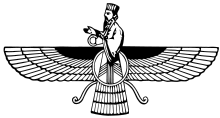| Part of a series on |
| Zoroastrianism |
|---|
 |
|
|
The Čihrdād nask[pronunciation?] or Kitradād nask is one of the lost nasks (volumes) of the Sasanian Avesta and survives only as summaries preserved in later Zoroastrian writings.[1] The text is said to have been a history of mankind from the beginning down to the revelation of Zarathustra, and it was an important source for later works like the Šāhnāmeh of Ferdowsi.[2]
Sources
The Čihrdād nask itself is lost but its structure and content can be reconstructed from references found in later Zoroastrian writings. The most important source is the Denkard, a 9th-10th century encyclopedia of Zoroastrianism. The 12th chapter of its 8th book provides a long description of its content.[3] In addition, the Rivayats, a series of letters from the 15th - 17th century, disucss its content briefly.[4]
Structure
The Čihrdād nask was part of the Sasanian Avesta, the Sasanian period collection of Avestan literature. This collection consisted of 21 nasks, which were grouped into 3 divisions; Gathic, ritual, and legal nasks.[5] Within this scheme, the Čihrdād nask belonged to the legal nasks although its content was not concerned with the law.[6] Edward William West estimates, that it consisted of ca. 2,600 words of Avestan text accompanied by ca. 23,400 words of translation and commentary in Pahlavi, which would make it the shortest legal nask and the second shortest overall.[7] Its grouping with the other legal nasks may have been due to a misinterpretation of the second element of its name as dād (law), whereas a derivation from *čiθrō.dāti (the establishment of the origins) is considered more likely.[1]
Content
The Čihrdād Nask is said to have contained a comprehensive account of the legendary history according to Zoroastrianism.[8] It began with the first man Gayomard all the way to the revelation of Zarathustra.[9] It is considered to have been an important source for the mythical history of Iran as perceived by the Sasanians. For example, the list of the Pishdadian and Kayanian rulers agrees with the order known from later Islamic writers.[10] In addition, the nask may have contained interpretations that used the mythical history to explain and justify the social order of the Sasanian empire.[11]
References
Citations
- ^ a b MacKenzie 1991.
- ^ Yarshater 1983.
- ^ Gignoux 1994.
- ^ Dhabhar 1932.
- ^ Kellens 1987, "The Sasanian collection of the Avesta and its commentary (zand) is described in chap. 8 of the Dēnkard; it was probably composed of three books of seven chapters [...]".
- ^ Shaki 1993a, "DĀD NASK (law book), one of the three divisions of the Avesta, comprising seven nasks, subdivided into the five strictly legal (dādīg) nasks [..] and the two disparate nasks, Čihrdād and Bagān Yašt".
- ^ West 1892, chap. Introduction.
- ^ MacKenzie 1991, "[T]he list of its contents [..] shows it to have been a history of mankind, with genealogies of the leaders of Iran from the beginning down to the revelation of Zoroaster and beyond.".
- ^ Yarshater 1983, pp. 416-435.
- ^ Yarshater 1983, p. 415.
Bibliography
- Dhabhar, Bahmanji Nusserwanji (1932). The Persian Rivayats of Hormazyar Framarz and Others. Their Version with Introduction and Notes. Bombay: K. R. Cama Oriental Institute.
- Gignoux, Philippe (1994). "DĒNKARD". Encyclopædia Iranica. Vol. VII. New York: Routledge and Kegan Paul. pp. 284–289.
- Kellens, Jean (1987). "AVESTA i. Survey of the history and contents of the book". Encyclopædia Iranica. Vol. III. New York: Routledge and Kegan Paul. pp. 35–44.
- MacKenzie, David N. (1991). "ČIHRDĀD NASK". Encyclopædia Iranica. Vol. V. New York: Routledge and Kegan Paul. p. 561.
- Shapira, Dan (1998). Studies in Zoroastrian Exegesis - Zand (PhD thesis). Jerusalem.
- West, Edward William (1892). Müller, Friedrich Max (ed.). Pahlavi Texts IV: Contents of the Nasks. The Sacred Books of the East. Vol. 37. Oxford university press. ISBN 1-139-41083-0.
- Yarshater, Ehsan (1983). "Iranian National History". In Yarshater, Ehsan (ed.). The Cambridge History of Iran. Vol. 3(1). Cambridge University Press. ISBN 978-0-521-24693-4.
External links
- Summary of the Čihrdād nask according to Book 8 of the Denkard by Edward William West
- Summary of the Čihrdād nask in the Rivayats by Ervad Bamanji Nusserwanji Dhabhar








